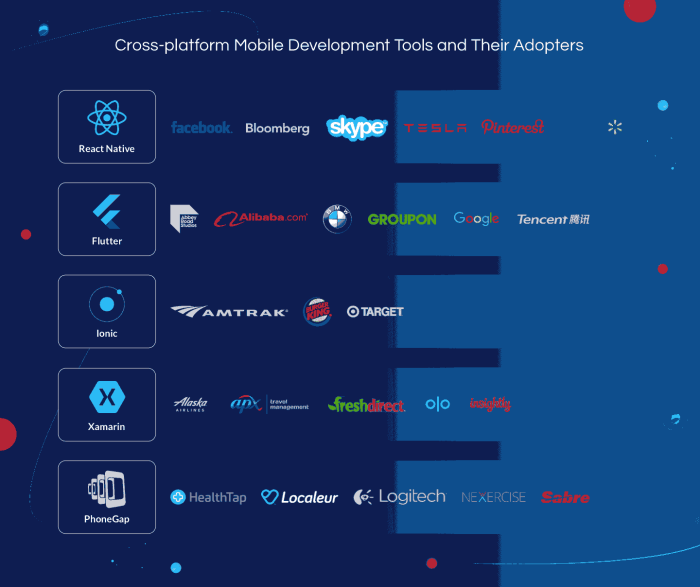Developing a Cross-Platform Strategy takes center stage, inviting readers into a world of business innovation and modernity. As we delve into the realm of cross-platform strategies, get ready for a ride filled with insights and strategic thinking.
From understanding the significance to tackling challenges, this topic is a goldmine of information for companies looking to thrive in today’s digital landscape.
Understanding Cross-Platform Strategy

Cross-platform strategy refers to the approach taken by businesses to create a consistent user experience across multiple devices and platforms. In today’s digital age, where consumers interact with brands through various channels, having a cross-platform strategy is crucial for success.
Implementing a cross-platform strategy offers numerous benefits for companies, including increased brand visibility, improved customer engagement, and higher conversion rates. By ensuring that customers can seamlessly transition from one platform to another while maintaining a unified brand image, businesses can enhance their overall marketing efforts and drive growth.
Examples of Successful Cross-Platform Strategies
- Amazon: Amazon has successfully implemented a cross-platform strategy by offering a seamless shopping experience across its website, mobile app, and voice assistant devices like Alexa. Customers can easily browse products, make purchases, and track orders regardless of the device they are using.
- Netflix: Netflix is another example of a company that has excelled in cross-platform strategy. Subscribers can watch movies and TV shows on their smart TVs, laptops, smartphones, and gaming consoles, with a consistent user interface and personalized recommendations across all platforms.
- Nike: Nike has leveraged a cross-platform strategy to create a cohesive brand experience for its customers. From its website to social media channels to mobile apps, Nike ensures that its messaging, products, and promotions are seamlessly integrated across all platforms, resulting in increased brand loyalty and engagement.
Key Elements of a Cross-Platform Strategy
When it comes to developing a successful cross-platform strategy, there are several key elements that need to be considered. These components are crucial in ensuring a cohesive approach across different platforms, ultimately leading to a more streamlined and effective user experience. Let’s dive into the essential elements of a cross-platform strategy.
Identifying Essential Components
- Consistent Branding: Maintaining a unified brand identity across all platforms is essential for building brand recognition and trust among users.
- Adaptive Content: Creating content that is optimized for each platform while still conveying a consistent message and tone.
- Seamless User Experience: Ensuring a smooth transition for users as they move between different platforms, maintaining a cohesive experience.
- Data Integration: Utilizing data analytics to gather insights from user interactions across platforms and optimize the strategy accordingly.
Aligning Branding Across Platforms
- Establishing Brand Guidelines: Developing clear guidelines for brand visuals, messaging, and tone to maintain consistency across all platforms.
- Visual Cohesion: Using consistent colors, fonts, and imagery to create a cohesive brand identity that resonates with users.
- Messaging Consistency: Ensuring that the brand’s voice and messaging remain consistent across all platforms, reinforcing brand values and positioning.
Role of User Experience
- Intuitive Design: Focusing on user-friendly design elements that enhance usability and navigation across different platforms.
- Personalization: Tailoring the user experience to individual preferences and behaviors to create a more engaging and relevant interaction.
- Feedback Mechanisms: Implementing feedback loops to gather user input and improve the overall user experience on all platforms.
Tools and Technologies for Cross-Platform Development
When it comes to developing cross-platform applications, having the right tools and technologies is crucial for a successful project. These tools help developers create apps that can run seamlessly on multiple platforms, saving time and resources.
Popular Cross-Platform Development Frameworks
- React Native: A popular framework developed by Facebook, known for its performance and efficiency in building native-like apps for both iOS and Android.
- Xamarin: Owned by Microsoft, Xamarin allows developers to write code in C# and share it across different platforms, providing a native user experience.
- Flutter: Created by Google, Flutter uses a single codebase to build visually attractive apps that work on both iOS and Android platforms.
Advantages and Disadvantages of Cross-Platform Development Frameworks, Developing a Cross-Platform Strategy
- Advantages:
- Cost-effective: Building one codebase for multiple platforms saves time and money.
- Efficiency: Developers can write code once and deploy it across different platforms.
- Consistency: Ensures a consistent user experience across all devices.
- Disadvantages:
- Performance limitations: Cross-platform apps may not perform as well as native apps.
- Platform-specific features: Some platform-specific features may be difficult to implement in cross-platform development.
- Dependency on third-party tools: Using frameworks may require reliance on third-party tools and libraries.
Choosing the Right Technology Stack
When selecting a technology stack for a cross-platform project, it’s essential to consider factors such as the project requirements, team expertise, and budget constraints. By evaluating these aspects, developers can choose the most suitable tools and technologies that align with the project goals and ensure a successful cross-platform application development.
Challenges in Implementing Cross-Platform Strategies: Developing A Cross-Platform Strategy

Implementing cross-platform strategies can be a complex task for companies due to various challenges that arise during the development process. These challenges can range from technical issues to resource management problems. However, with the right strategies and solutions in place, companies can overcome these hurdles and successfully execute their cross-platform strategy.
Compatibility Issues
One of the most common challenges in cross-platform development is dealing with compatibility issues. Different platforms have unique features and requirements, which can make it difficult to create a consistent user experience across all devices. To overcome this challenge, developers need to conduct thorough testing on multiple devices and platforms to ensure that the application functions correctly.
Performance Optimization
Another challenge companies face is optimizing the performance of their application on different platforms. Each platform has its own performance limitations and requirements, which can impact the overall user experience. To address this challenge, developers should focus on optimizing code, reducing unnecessary features, and leveraging platform-specific tools for performance enhancement.
Resource Management
Managing resources effectively is crucial for the success of a cross-platform strategy. Companies need to allocate resources wisely, balancing the needs of multiple platforms while staying within budget and timeline constraints. By prioritizing tasks, setting clear goals, and leveraging cross-platform development tools, companies can streamline resource management and ensure successful execution of their strategy.
